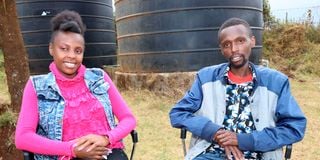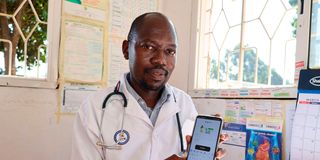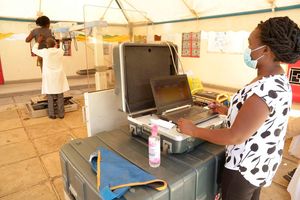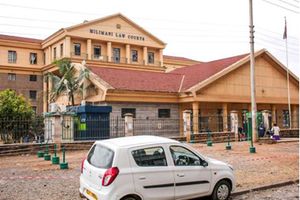New machines, old coughs: How Kenya is fighting TB with technology

Abidoris Wangari and her brother Timothy Njenga, who was diagnosed with TB in August last year, during the interview.
What you need to know:
- TB remains a leading cause of death worldwide and is the fourth cause of death among infectious diseases in Kenya.
- It is one of the leading infectious disease killers in the world, claiming 1.5 million lives annually.
- In Kenya, every year about 120,000 people develop TB (48,000 of them being HIV-positive) and 18,600 die from it. TB was responsible for about 3.2 per cent of all deaths in 2020, killing 20,000 Kenyans.
On the day that Abidoris Wangari and her mother went for their tuberculosis results, the hospital benches seemed too hot to sit on. Hope eluded them, but they clung on it, anyway. The waiting room was clouded by anxiety and their faces painted a pensive mood.
The two have been caretakers of their brother and son; Timothy Njenga, who was diagnosed with TB in August last year. By all means, they were at risk of getting the preventable yet curable disease because of its contagious nature.
Every day, Abidoris cleaned up her brother’s mess, changed his bedding and served him food. When he coughed, they breathed the same air, and she was happy to help as long as her brother had a shoulder to lean on.
When Timothy was diagnosed with TB, the hospital insisted that his caretakers accompany him to the clinic. This is because of the risk that caretakers have when handling such patients. But, there is a way out. A preventive measure called the Tuberculosis Preventive Treatment (TPT) is given to the caretakers in the form of a medicine dosage.
“My mother and I were tested, counselled and placed on the preventive therapy drugs. We were given 10 tablets a day and in the three months we took the drugs, it was a stigma-filled period. People did not understand that they were preventive — we were labelled a family of sick people,” says Abidoris.
After three months, the two went to hospital for a second round of testing just to be assured that we were free from the disease. Surprisingly, they had not contracted it, thanks to the preventive drugs.
“Agreeing to take the drugs was the best decision we ever made as a family because we would be attending to my brother all the time, even when he vomited,” says Abidoris.
While on treatment, she stayed hydrated and managed the effects of the drugs quite well.
Timothy had a rough time after his diagnosis, but because of the preventive drugs, he was embraced by the family.
“Many thought I was going to die because TB was majorly associated with HIV, people talked behind my back but due to all the pain I had gone through, I was determined to finish my six-month regimen,” he tells Healthy Nation.
“I am glad I am done with my drugs and my sister and mum are free from the disease. I am still weak but I feel better,” he says.
The journey to eliminate TB in the country is long and windy, but still on course. The Health ministry in July last year launched the TB Innovative Technologies Tools Project (iNTP) for screening, diagnosis and prevention to accelerate the national response of eliminating TB by 2030.
Kenya is one of 11 countries selected globally for the iNTP because of high TB burden and the country’s zeal to attain the World Health Organization’s (WHO) goal for eliminating TB.
Funded by the United States Agency for International Development, the Health ministry’s National TB Program and Centre for Health Solution are spearheading the programmes that have tools for TB screening, diagnosis and prevention.
The portable equipment are benefiting TB patients as the country strives to find missing cases and end the epidemic in line with the declarations made during the 2018 UN High-Level Meeting on TB.
“TB case finding and laboratory diagnosis form the backbone of quality patient care and disease surveillance, that’s why we introduced the new tool to improve diagnosis, prevention and treatment of TB,” says Dr Josephine Mburu, Health Principal Secretary .
“The roll-out of tools in the country has a far-reaching implication for healthcare and public health. It has improved diagnostic capabilities and increased access to healthcare. The new tools are portable and easier to transport particularly in large rural areas like Turkana,” explains Dr Kisia Jaqueline, acting head of the National Tuberculosis Program.
Every year, about 120,000 people in Kenya develop TB (48,000 of them are living with HIV) and 18,600 die from it.
This is despite the disease being curable and preventable. Most patients seek medical attention at an advanced stage when they have developed acute tuberculosis.
Kenya is one of the 30 countries with the majority (at least 80 per cent) of TB cases.
The burden for TB, TB/HIV and Drug-Resistant TB (DR TB) still remains high. But all is not doom and gloom.Here are some of the tools being rolled out by the ministry to help in lessening the TB burden.
TB Preventive Treatment (TPT)
TB preventive therapy is a relatively new intervention in TB control in Kenya.
Ms Patricia Mwangi, Lari Sub-county’s TB and Leprosy coordinator, notes that Kiambu County has since acknowledged the importance of preventive treatment. This is the treatment that Timothy’s mother and sister took to avoid contracting the disease. “The country has concentrated so much on TB disease and forgotten the infection and that’s why TPT must be embraced for us to defeat this disease,” she says.
Those eligible for the treatment include latent patients (persons with latent TB infection do not feel sick and do not have any symptoms. They are infected with the bacterium that causes the disease but do not have TB disease), prisoners, healthcare workers, household contacts (family members close to patients diagnosed with active TB) and HIV patients.
They have to be screened first to ensure that they have not been infected before getting the regimen.
At Lari Level Four Hospital, about 121 patients have been on TPT and only two developed active TB. “The drugs are taken once in a lifetime and this does not guarantee that one may not develop active TB after exposure. There is a likelihood that one can get active TB but the chances of one progressing to severe TB disease are minimised,” says Patricia.
TrueNat
Truenat is a diagnostic tool that strengthens TB care and prevention.
Ms Rose Gikonyo, a laboratory technologist at Lari Level 4 Hospital, received the machine last year in June and since then, the turnaround time for TB tests has improved to one hour unlike before when it would take more than a week before the results would be released.
The results are dispatched online to clinicians in form of short messages and emails using a locally developed electronic reporting platform called the Tibulims system. This reduces the time taken to put a patient under treatment.
Since the tool was rolled out, the number of cases being diagnosed has gone up. For instance in 2021, about 353 cases were diagnosed in Lari Sub-county. By the end of 2022, after receiving the machine, the number doubled.
At Lari Level 4 Hospital alone, the number of patients diagnosed increased from 50 to 101 in 2022. The machine uses sputum.
Previously, the hospital would transport specimens to Kiambu Level Five Hospital and transport challenges would delay the whole process.
The machine can test up to 12 samples in a day. It first does the normal TB detection and also the Multi-Drug Resistance test to establish whether the patient is resistant to any of the drugs.
“One of the reasons why most cases are missed is the limited access to rapid molecular testing, especially in the lower-level healthcare facilities: only half of the people with TB get tested with a rapid molecular test at the time of diagnosis. But this machine picks even the lowest micro bacteria and this has improved TB diagnosis and case finding in the sub- county,” says Rose.
The machine is battery-powered and uses room-temperature stable reagents. It is portable and is normally used during rural outreaches. Once charged, it can work for seven hours without shutting down.
It can generate results for a TB test in one hour and detection of resistance to a TB drug called Rifampicin in another hour.
Lari Level 4 Hospital has so far done 502 tests out of which 36 turned positive; with only one drug resistance case identified by the machine.
Through the National TB Program and TB Accelerated Response and Care II (ARC II) support, the facility was assessed for capacity to accommodate molecular diagnostic tools including Truenat assay.
Thirty eight machines were distributed to 33 counties.
The Ministry of Health data show that about 16, 359 tests have been done by Truenats across the country, with 1,705 testing positive for TB and 108 drug resistance cases reported. All patients who tested positive have been initiated on treatment.
The Interferon Gamma Release Assays (Igra) for latent TB testing
According to the World Health Organization, there are two groups of TB patients; Latent TB and TB disease. Latent TB infection occurs when a person is infected with the TB bacteria but does not have any symptoms.
The Interferon Gamma Release Assays are majorly for latent TB testing using an enzyme-linked immunosorbent assay machine.
Kenya has two Igra machines to aid in detection of TB infection
The tool tests for latent TB infection among high-risk groups including healthcare workers, household contacts of confirmed TB patients and prisoners so as to increase the TB preventive therapy (TPT) uptake.
Previously, high-risk groups were initiated on TPT before testing due to unavailability of Igra testing reagents.
According to the data from the ministry, since the introduction of the machine, about 2,209 tests have been carried out so far and 1,100 latent TB confirmations from tests done using IGRA confirmed positive
At Pumwani Maternity Hospital, which is a high-volume facility, the laboratory was equipped with the machine, which is testing for the 11 sub-counties in Nairobi. All samples referred from other sub-counties are tested and results dispatched back for clinical decisions.
Digital chest x-ray
While Kenya is a high-burden TB country, 40 per cent of persons with TB do not get a diagnosis. But the digital x-ray helps clinicians detect the disease early. Eight digital chest x-ray machines have been distributed to seven counties.

Nicodemus Adera, a clinical officer at Chandaria Health Centre, Dagoretti South in Nairobi shows how digital adherence technology for TB patients works.
So far about 9,432 people have been screened using the computer-aided portable digital chest x-ray. At Mathare Health Centre, which majorly serves informal settlements in Nairobi, 1,025 people have been screened using the machine. Fifty six of these were confirmed to have TB and started treatment.
Previously, patients would be referred to private facilities, where they are required to pay Sh1, 500 for the X-Ray.
“Digital chest x-ray machines provide more detailed and accurate images than traditional film x-rays, leading to better and more timely diagnosis. Our doctors can now easily identify and interpret patterns in the images that may not be immediately apparent to the human eye, leading to earlier detection of TB disease,” Dr Kisia tells Healthy Nation.
Digital adherence technology (DAT) -TB treatment
The tool is aimed at enhancing adherence to TB treatment. It is spread across 186 facilities in Nairobi and Mombasa counties. Through iNTP, 5,000 DST (Drug susceptible TB) patients were enrolled in the system.
Data from the Health ministry show that over 10,000 patients have been enrolled in the system. Monica Wanjiku is one of them. On December 29, 10 days after having the symptoms, she decided to go to the hospital for a medical checkup. “The doctors scanned my lungs using an X-ray machine. My chest had a lot of water, something I was told is called pleural effusion. I was diagnosed with tuberculosis that day and was given drugs that I was to take for six months,” she tells Healthy Nation.
At the hospital, she was introduced to the DAT technology and was advised to send codes found on her tablets using the USSD *384*4000 #. “Every time I take medicine, I ensure that I send my code by dialling *384*4000 #. When I don’t get feedback, I call the doctor to seek clarification,” she says.
Monica admits being forgetful and says the code has helped her adhere to the medication.
“I take my drugs every day at 9pm because that is the time I am settled in my house with minimal distractions,” she says. With adherence to the drugs and proper diet, she has gained four kilogrammes and is on road to recovery.
Nicodemus Adera, a clinical officer at Chandaria health centre in Dagorreti South, Nairobi, says the app ensures that all patients take their medicines every day and update the doctor.
“We started using it last year in December.”
Adera tells Healthy Nation that he is always in contact with his patients until they finish their dosage. He assures patients that their data is safe, and the application is easy to use. “In this clinic, for instance, I am the only one with the password, I cannot edit or delete anything once it has been uploaded,” he says.
While the application helps patients to adhere to drugs, it is a useful tool for data.
“The government can use this in future to retrieve data anytime they need it from the facility level to the national level. Since we are working towards eliminating TB by 2035, if we embrace this technology, then we can closely monitor our patients and achieve the 90 per cent target for treatment,” he explains
The technology also helps in reducing cases of loss to follow, which refers to patients who end up with multidrug-resistant TB cases because they failed to complete the treatment.
“Our tracker shows that we have been improving and by the end of last year, we were at 95 per cent against the national target of 90 per cent, rising from 54 per cent in 2017,” he says.






